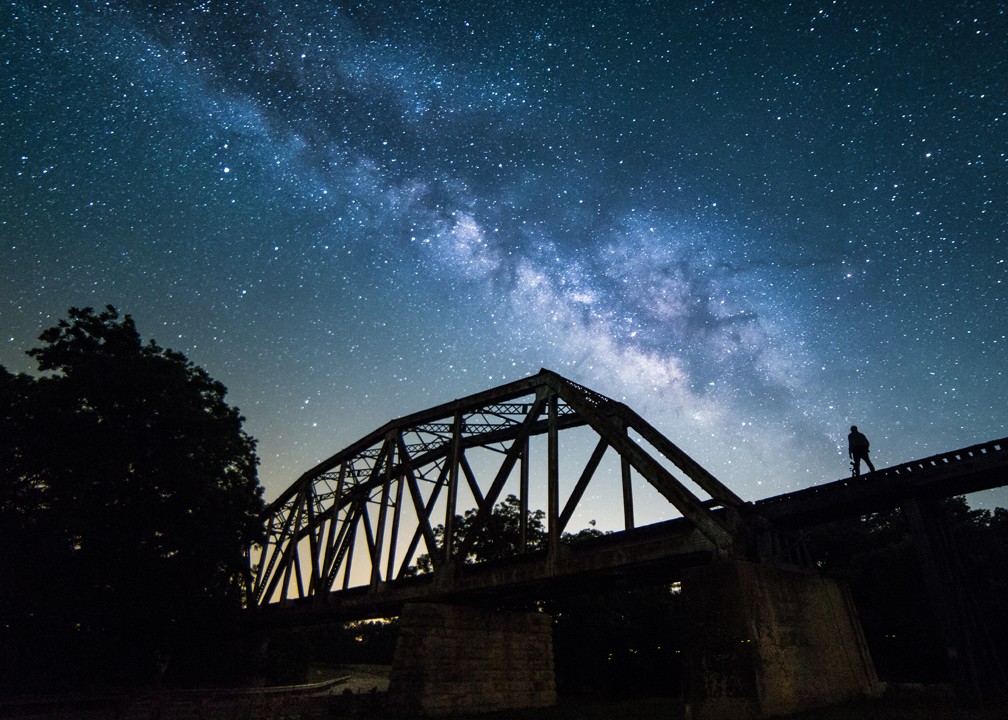James Murr | The Junction Eagle |
Public interest continues to grow in preserving the “awe-inspiring night skies” of the Texas Hill Country. Local communities can derive significant economic benefits from visitors who come for stargazing, which is no longer possible in many areas because of light pollution that seriously interferes with or prevents the viewing of heavenly objects during the nighttime.
In 2011 and 2012, the Kimble County Commissioners Court and the City Council of Junction passed resolutions that supported voluntary actions by individuals and businesses to help protect this area’s scenic night skies. This article describes some actions taken since then and the outlook for preserving the dark skies.
The use of excessive or improperly shielded lighting results in two types of light pollution. First, there is the light that escapes upward resulting in the stars being almost invisible at night in many parts of the nation – not much star gazing going on in our big cities. Second, there is light pollution more aptly described as light trespass, where lights shine onto the properties of an adjacent neighbor or neighbors.
Night Skies friendly lighting focuses the light downward and also reduces light trespass. It is usually of a lower wattage, avoids the “glare” that makes it difficult for the eyes to adjust, and results in less costly electricity bills. Many lighting changes can be made fairly easily with immediate reductions in light pollution.
In 2013, the Hill Country Alliance received a grant from the Coypu Foundation that was used to replace light-polluting fixtures in the City of Junction, including over 100 lights along Main Street and residential streets. Some of the remaining grant funds were then used for education and outreach programs on the aesthetic, environmental, and economic benefits of more night skies friendly lighting.
Our community’s South Llano River State Park (the Park) was recently designated an International Dark Sky Park. This designation from the International Dark-Sky Association is reserved for public and certain privately-owned land that possesses “an exceptional or distinguished quality of starry nights and a nocturnal environment that is specifically protected for its scientific, natural, educational, cultural heritage, and/or public enjoyment.” The Park’s website includes information about night skies viewing and related activities at the Park.
Texas Tech University (TTU) in Junction has installed software to monitor the night skies as part of its effort to obtain a dark skies designation. TTU’s Junction Outdoor School also offers an astronomy teaching unit for participating independent school districts. Robert Stubblefield, the Director of Operations for TTU-Junction, reports that “it’s amazing how many kids are literally in awe when they see the stars out here and particularly so with inner city kids who are truly seeing the stars for the first time!”
As recently as May 19, a Hill Country Dark Sky Conference was held in Fredericksburg. Recognized experts addressed topics such as A Dark Skies Vision for the Texas Hill Country; Lighting Design; Street Lights and Working with Utilities; Working with Developers; Ordinance Development and Implementation; and Economic Impact and Marketing our Communities. Around 50 individuals from 14 communities attended the conference, which was sponsored by the Hill Country Alliance, the City of Fredericksburg, the Gillespie County Economic Development Commission, and the Putman Mountain Observatory.
The replacement of the City of Junction’s 100+ street lights was an important step in making Junction more night skies friendly with the benefit of attracting more visitors. Since that time, however, some have observed that lighting has been installed at various locations that is not as night-skies friendly. The aforementioned night skies resolutions passed by the Commissioners Court and the City Council remain the basis for encouraging voluntary efforts to use night skies friendly lighting. (Note: The City Council has the authority to regulate lighting fixtures, but the Kimble County Commissioners Court does not.)
As reported at the time the resolutions were passed, night skies friendly lighting is about more than aesthetics and being a good neighbor. Increasingly, visitors are coming to our community for stargazing, as well as for hunting, fishing, bird watching, kayaking, and other nature related activities. These visitors, most of whom stay overnight, bring tangible economic benefits to our area. In Kimble County, protecting the night skies from further degradation by light pollution will depend on the voluntary efforts of individuals, businesses, landowners, builders, and our local governments.
Other communities in the Hill Country continue to consider the merits of voluntary or regulatory approaches to the light pollution problem. If the area’s night skies are to be preserved, all the communities will need to act, as the effects of light pollution – a glowing night sky created by city lighting – can reach far beyond the boundaries of a single community.
The websites of the following organizations provide a wealth of information on the many aspects of the night skies: Hill Country Alliance; Texas Parks & Wildlife Department; South Llano River State Park, and the International Dark-Sky Association.

